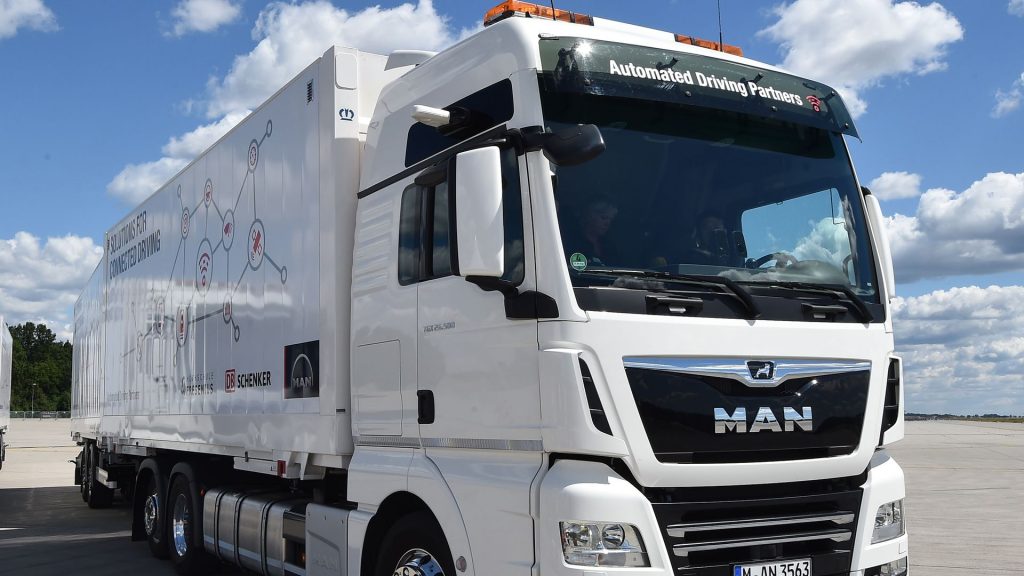The road to autonomous tractor-trailers is full of obstacles. Where do we stand?

The road to autonomous trucking is a winding one with many turns still ahead. “Robotrucks” magnify the concerns many have about “robotaxis” and other autonomously driven cars, which are grabbing headlines as their presence grows on city streets. While some root for the arrival of self-driving cars, others worry they are not fail-safe and may cause accidents.
Once their autonomous driving (AV) technology is fully implemented, heavy-duty robotrucks will take to the highway with no human driver in the cab. Some of the world’s largest commercial truck builders and their technology partners are already evaluating their AV trucks under development on public roads.
“Very early driverless and monitored runs are underway in Texas, where a ‘safety driver’ [a human in the cab who can take control] or other close monitoring is in place,” said Dean Bushey, director of programs at the trucking research nonprofit North American Council for Freight Efficiency.

When can we expect autonomous tractor-trailers to hit the road?
“If progress keeps up, we can expect modest yet significant commercial scaling around 2028 to 2035 on select routes,” Bushey told Straight Arrow News. “A national rollout is a longer-term game, likely after 2035 to 2040, depending on federal regulations, insurance models and public trust. There will be a modest rollout, not a large-scale conversion to autonomous driving trucks.”
Tractor-trailers — rated for a maximum combined vehicle weight of 80,000 pounds — are miles apart from a taxi in size, horsepower and other capabilities. Trucks are packed with advanced technologies that control everything from engine performance and exhaust emissions to onboard telecommunications. How those systems work is critical as trucks haul over 70% of the nation’s freight by weight.
Autonomous driving adds a layer of complex technology that must integrate with the truck’s existing systems. There are no shortcuts to sending out heavy trucks with no driver on board. As with cars, autonomous systems for trucks are defined by SAE Levels of Automation. These describe concepts and track progress on the way to fully driverless trucks. At the top is SAE Level 5, defined as achieving automated capability that can fully drive the vehicle “everywhere in all conditions.”
It’s an incremental journey. Truck makers and AV partners are advancing the technology while also tackling roadblocks to acceptance, including governmental and public acceptance that autonomous trucks are safe and that necessary changes to roadway infrastructure are achievable. In addition, the business case for AV heightening efficiency for truck fleets must be made before they invest directly in robotrucks.
Autonomous trucks could help correct the deep and recalcitrant shortage of qualified tractor-trailer drivers. Between wanting AV and getting it, though, motor carriers will thread the needle of redeploying some drivers to other roles and working with labor unions on the impact.
“For fleets, the AV draw is all about cost reduction of operating expenditures in exchange for increases in capital expenditures,” said Rick Mihelic, director of emerging technologies, North American Council for Freight Efficiency. “Taking the human driver out will reduce operating expenditures by 20% to 30%, plus possibly other cost reductions from fewer accident lawsuits. AVs will reduce accident rates, but those accidents that still occur will be severe, as is seen with AV cars.”

Are self-driving semitrucks safe?
Safety is the ultimate AV watchword. A typical robotaxi tops out at 5,400 pounds, while a robotruck tractor-trailer combination may weigh up to 80,000 pounds, the same as those now with drivers onboard.
Truck fleets are regulated heavily by the federal and state governments to ensure safe operation, and all trucks are built to mandated safety standards. Accidents are anathema to trucking because they are expensive and disruptive to its operations. They also drive up insurance costs, and they give the industry a black eye.
Truck builders and fleet owners don’t speak of robotrucks. To emphasize the science and engineering going into the new technology, they are referred to as autonomously driven vehicles.
Sasko Cuklev, head of on-road solutions for Volvo Autonomous Solutions, told SAN that a “precise timeline to deliver a safe, fully autonomous Class 8 [heavy-duty] trucking solution is uncertain,” adding, “We continue rigorous testing and validation with safety drivers to ensure reliability and public safety.”
As regulations and technology evolve, Cuklev said “the need for human oversight — onboard or remote — will diminish, paving the way for seamless, driverless freight operations.”
AV trucks will need to follow federal safety mandates, but states control access to their roads. Regulators are aware of the infrastructure issues as well.
Self-driving will require trucks that can handle what’s unpredictable, such as road debris, navigating complex urban merges and construction zones. That will require robust sensing capabilities and sure-footed, immediate decision-making.
In January, the National Highway Traffic Safety Administration (NHTSA) proposed a voluntary framework for reviewing and overseeing vehicles equipped with automated driving systems (ADS). The proposal contains reporting requirements for participants, including periodic and event-triggered reporting.
Information gleaned by NHTSA may lay the foundation for future AV performance standards and related regulations. But none of this will write new rules with any speed.

Why are some states ahead of others in the self-driving truck journey?
Meantime, states hold broad authority over road use, permitting and operational access. Road access remains a patchwork: Some states, including Texas, Arizona and New Mexico, allow testing and setting up AV commercial routes.
“We are clear to deploy autonomous trucks in most states,” said a spokesperson for Aurora, an AV developer partnered with global truck makers Volvo and PACCAR. “We’re focused on deploying in the Southwest and expanding from there. Texas and neighboring states are where our [fleet] customers are and where they have the greatest volume of goods that need to be moved. As to customer value, autonomous trucks will be able to operate nearly all day, which will increase asset utilization and strengthen bottom lines for motor carriers.”
Widespread driverless operation will shift liability from driver negligence to issues with system performance that may affect fleets and truck makers — potentially slowing AV adoption.
Insurers are still figuring out how to underwrite these new risk profiles. Many will require demonstrations of long, consistent safety records and independent assessments before extending liability coverage, further reinforcing incremental adoption, rather than a rapid switch.
That aligns with fleets that opt to commercialize AV within defined limits, such as over limited-access interstates, in clear weather windows, and using fixed origin/destination pairs. Autonomous trucks promise lower labor costs and higher vehicle use.
However, the upfront costs of the technology and upfitting it to trucks are substantial. But deploying AV on closed routes may pay back faster, helping to push adoption forward.
Volvo’s Cuklev said that AV technology will “create a safer and more efficient future for freight delivery.” Autonomous driving will make moving freight more reliable and consistent, “even as the industry grapples with [driver] staffing challenges and rising demand. We see autonomous trucking as a key to adding much-needed capacity and helping the entire logistics system become more efficient and resilient.”
The post The road to autonomous tractor-trailers is full of obstacles. Where do we stand? appeared first on Straight Arrow News.





